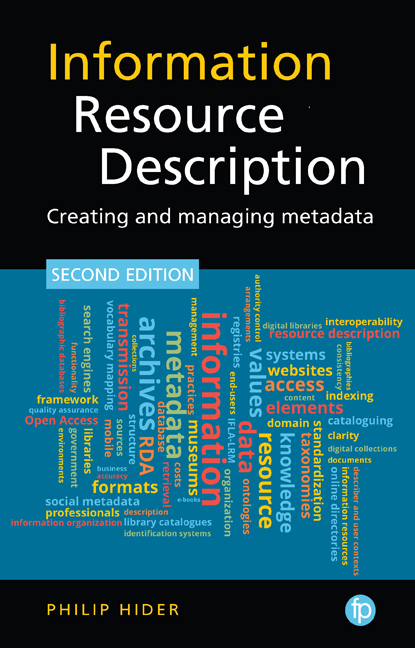Book contents
- Frontmatter
- Dedication
- Contents
- List of figures and tables
- Preface to the First Edition
- Preface to the Second Edition
- List of abbreviations
- 1 Definitions and scope
- 2 Information resource attributes
- 3 Tools and systems
- 4 Metadata sources
- 5 Metadata quality
- 6 Sharing metadata
- 7 Metadata standards
- 8 Vocabularies
- 9 The future of metadata
- Further reading
- List of metadata standards
- Index
Preface to the Second Edition
Published online by Cambridge University Press: 24 September 2019
- Frontmatter
- Dedication
- Contents
- List of figures and tables
- Preface to the First Edition
- Preface to the Second Edition
- List of abbreviations
- 1 Definitions and scope
- 2 Information resource attributes
- 3 Tools and systems
- 4 Metadata sources
- 5 Metadata quality
- 6 Sharing metadata
- 7 Metadata standards
- 8 Vocabularies
- 9 The future of metadata
- Further reading
- List of metadata standards
- Index
Summary
Information organization may not be the fastest moving field in the world, but neither does it stand still. While much of the general thrust of the first edition of this book remains applicable to the world of metadata and information organization in 2018, some of the specifics have changed in significant ways since it was published in 2012. For example, the library cataloguing code, Resource Description and Access, has now been adopted by most libraries in the English-speaking world, and related standards such as BIBFRAME are coming into view as more concrete propositions. On the whole, however, I would be inclined to characterise the intervening years as a period of ‘evolution’ rather than ‘revolution’ for the field, in which some of the key ideas that emerged over the previous decade or so have been applied, and refined, in many more operational settings. Information organization systems have become more integrated with the rest of the digital information environment, and their search interfaces look more ‘21st century’ (which is just as well, given that we're almost one fifth of the way through it!).
Whether we continue down this evolutionary path over the next five years only time will tell. Some would argue that we are, instead, on the cusp of a period of revolution, in which the field is transformed through the ascendancy of ‘linked data’. For want of a crystal ball, I have tried to steer a middle course, highlighting the potential of linked data and the work going on in this area without making unfounded claims for its future. After all, we've been talking about the ‘Semantic Web’ since the early 2000s.
Perhaps what I have appreciated the most, over the past five years, has been the quality of the thought and scholarship underpinning the evolution of information organization practice. I have cited some of the key papers and books produced by this scholarship in the text, particularly in the later chapters; in addition, there is an updated list of books (and e-books) for further reading at the end. There are likewise many more references to websites and other online resources throughout this new edition.
- Type
- Chapter
- Information
- Information Resource DescriptionCreating and Managing Metadata, pp. xv - xviPublisher: FacetPrint publication year: 2018



